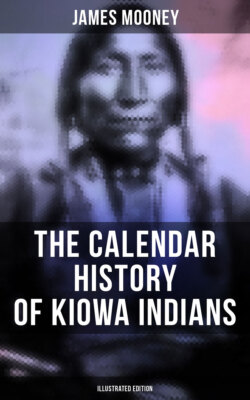Читать книгу The Calendar History of Kiowa Indians (Illustrated Edition) - James Mooney - Страница 53
The Little Arkansas Treaty in 1865
ОглавлениеIn a few months the grass was up and a change came o'er the spirit of the dream. Hostilities had begun on the plains, and in order that the innocent might not be punished with the guilty, the friendly tribes along the eastern border had been forbidden to go out into the buffalo country. This deprivation of accustomed privileges naturally caused great dissatisfaction among the friendly Indians, who had come to depend on their annual buffalo hunt to eke out their scanty food supply, and they complained bitterly that the government had been feeding and clothing the hostiles, while they themselves had been left to starve. In a strong letter their agent writes that, while he has a desire to shield all Indians from wrong and severe treatment, yet "lead, and plenty of it, is what the Kiowas want and must have before they will behave." He denounces them as murderous thieves, and says that he has had personal experience of their insolence and outrages (Report, 13). The incidents of this war noted on the calendar are the encounter at Fort Larned, in which the Kiowa ran off the horses of the soldiers, and the attack on a Kiowa camp by a detachment of troops and Ute Indians under command of Kit Carson (see the calendar).
From the agent's report it appears that the Indians had begun hostilities in the summer simultaneously on the Platte and the Arkansas, and up to September had killed a number of people and run off several thousand head of horses, mules, and cattle. Communication between the Colorado settlements and the Missouri had been almost entirely cut off, the overland coaches had to be supplied with large escorts, and emigrant trains were compelled to combine for safety. It was thought that all the tribes of the plains were on the warpath together. The Indians were well mounted, knew the whole country perfectly, and so far, in every contest on anything like equal terms, had proven themselves a match for the white soldiers. As nearly the whole available force of the government was then employed in suppressing the rebellion, no additional troops could be sent to the frontier, and Governor Evans of Colorado asked and received permission to raise a force of volunteers against the hostiles. It was the opinion of many persons, including army officers stationed in the country, that the whole trouble might have been averted had the Indians been properly treated by the whites (Report, 14).
In spite of the serious condition of affairs it was evident that the chiefs did not want war. Early in September peace overtures were received from the Cheyenne and Arapaho, who soon after came in and camped as directed near Fort Lyon, Colorado. A month later the agent reported that the Kiowa and Comanche had committed no depredations for a long time and were supposed then to be south of the Arkansas, near the Texas border (Report, 15). Before the trouble began they had been encamped on the Arkansas, near Fort Larned. As the tribes had now expressed their desire for peace, a commission was sent out early in 1865 to meet them for that purpose. The commissioners met the Kiowa, Comanche, and Apache on August 15 at the mouth of the Little Arkansas, where now is the town of Wichita, Kansas, and received their promise to cease hostilities and to meet the same commission in October to make a regular treaty of peace. Three days later the Cheyenne and Arapaho entered into a similar agreement at the same place. The Kiowa chiefs signing the agreement were Dohásän as head chief, Gúi-pä´go ("Lone-wolf"), Sét-dayâ´-ite ("Many-bears"), Set-t'aiñte ("White-bear"), Te'né-angópte ("Kicking-bird"), and Set-ĭmkía ("Pushing-bear," commonly known as Stumbling-bear), with Sét-tádal ("Lean-bear") for the Apache, and eight of the Comanche. Credit for this result is due largely to the efforts of agent Leavenworth, who secured a suspension of military operations while he went out to bring in the Indians, a matter of peculiar difficulty in view of their fresh recollection of the massacre of friendly Cheyenne by Colonel Chivington in the autumn of the preceding year (Report, 16).
Pursuant to agreement, commissioners met the five tribes in October, 1865, at the mouth of the Little Arkansas, where treaties were made with the Cheyenne and Arapaho on the 14th, with the Apache on the 17th, and with the Kiowa and Comanche on the 18th. By the treaty with the Apache they were officially detached from the Kiowa and Comanche and attached to the Cheyenne and Arapaho, who agreed to relinquish their reservation in southeastern Colorado for one farther south, in Kansas and Indian Territory. The Kiowa and Comanche agreed to remove south of the Arkansas, the reservation proposed for their future home being a tract in western Texas and Oklahoma, as follows: Commencing on the Canadian river where the eastern line of New Mexico crosses the same; thence running south along said line to the southern boundary of New Mexico; thence in a northeastwardly direction to the headwaters of Big Wichita river; thence down said river to its mouth or its junction with Red river; thence due north to Canadian river; thence up the Canadian to the place of beginning. By this treaty, which was intended, to be only temporary, they gave up all claims in Colorado, Kansas, and New Mexico, and were restricted to southwestern Oklahoma and the region of the Staked plain in Texas. Five white captives were surrendered by the Kiowa and Comanche at the same time (Treaty).
